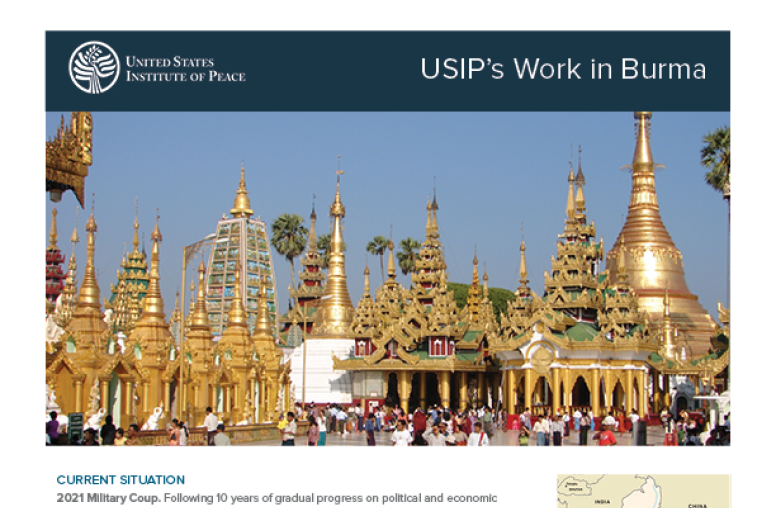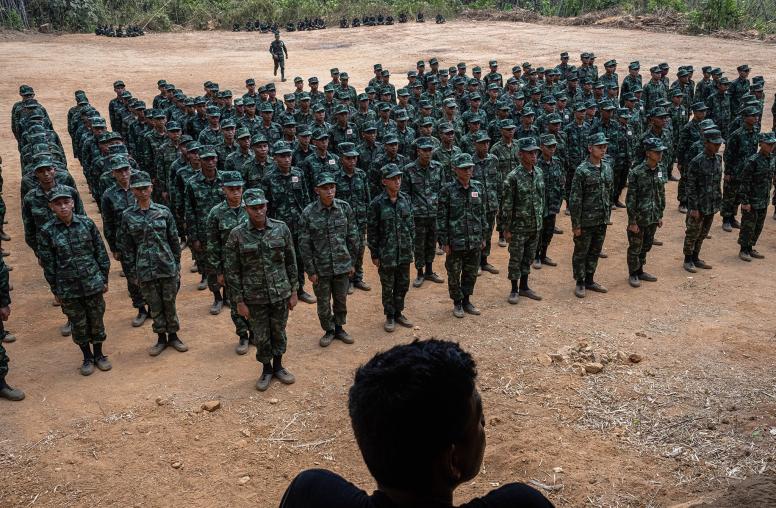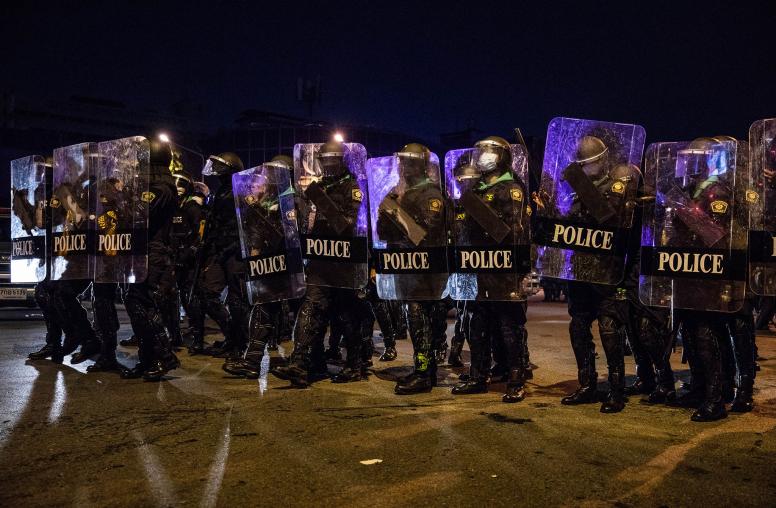Insurgents in Myanmar’s Rakhine State Return to War on the Military
As a cease-fire collapses, the powerful Arakan Army emerges as a centerpiece of national resistance to the ruling generals’ junta.
Serious combat has resumed in Myanmar’s Rakhine State, despite a continuing de facto cease-fire declared by the military just before its coup last year. Unlike previous rounds of fighting in Rakhine that could be viewed as a localized internal conflict, the renewed violence is taking place in the context of a nationwide civil war triggered by the coup, and its consequences are spreading far beyond the state’s borders. The resumption of war in Rakhine State, in short, could be a hinge on which the future of the resistance’s self-described “Spring Revolution” will turn. Its progression bears close watching.

The Rakhine insurgency is putting such pressure on the junta’s thinly stretched ground troops that the ruling generals have been forced to employ heavy weapons, aerial strikes and naval guns against their widely dispersed internal enemies. Meanwhile, Rakhine’s rebel Arakan Army has continued to gain strength. It has ousted the military from many of its posts in the state’s north, and by supporting the resistance Peoples Defense Forces and fighting alongside its traditional allies in the east of the country, sharply intensified the challenges the ruling generals face as they struggle to gain control of Myanmar.
The Arakan Army’s expanding ties with the national resistance movement is undoubtedly the military’s most critical concern in Rakhine, fueling its increased presence there in recent months and the resulting rise in tensions. The Arakan Army (AA) has reportedly trained and provided technical support and weapons to numerous armed resistance groups around the country while its previously unspoken support for the National Unity Government (NUG) has become open policy — along with declared hostility toward the junta administration.
A Chronology of Combat
In early June the AA rebuffed a junta invitation to peace talks in Naypyitaw, and the army began reinforcing its troops throughout Rakhine. On a June 13 visit to Rakhine, the vice chief of the regime’s administration instructed his soldiers to be “ready to fight anytime.” Shortly thereafter junta forces began arresting people thought to be affiliated with the AA in the cities of Mrauk-U, Sittwe, Kyauktaw and Ponnagyun, blocked the gates of these towns, and conducted regular checks of hotels, guest houses, and residences in search of members of the AA and its political wing, the United League of Arakan (ULA).
While military tensions were rising in Rakhine, armed clashes resumed in July when the junta launched an airstrike on an AA base in the Karen National Union (KNU) territory in Karen State. At least six AA soldiers died in the assault and more were injured, while a garment factory and medical clinic were also destroyed. Twelve days later, the AA attacked junta forces in northern Rakhine’s Maungdaw township, killing at least four soldiers, injuring many others, and capturing at least 14 troops. Subsequently, a series of armed clashes broke out across Rakhine, and the city of Paletwa and elsewhere in Chin State.
On August 23, the AA urged people to stay away from outposts and checkpoints of junta troops and border guard police and to notify relevant AA and ULA offices in advance if they needed to travel to deal with life-threatening and health emergencies. On September 14, the AA further announced that all vehicles moving on rivers or highways in Rakhine would be checked. Soon after, all public transport ships across Rakhine ceased to operate. Most recently, the military has blocked all land and river traffic in and out of Rathedaung township in northwestern Rakhine.
War in Rakhine Enters New Phase
The resumption of war in Rakhine differs from the previous 2018-20 conflict in terms of conflict landscape, missions, morale levels and exogenous factors.
The previous armed clashes between the military (now called Sit-Tat) and the AA were quite new to the people and areas of Rakhine, and Myanmar soldiers at the time enjoyed high morale due to past victories in Kokang, northern Shan State and elsewhere. Although support for the AA’s military mission was growing among Rakhine people, AA soldiers were fighting the Sit-Tat alone as many other armed ethnic organizations had joined the Nationwide Cease-fire Agreement (NCA) or bilateral cease-fires in the other parts of the country.
An exogenous factor was that the NLD sat at the head of the government in those years and collaborated with the military’s fight against the AA. The de facto leader of the government, Aung San Suu Kyi, who is now in prison, went so far as to praise the Sit-Tat soldiers in April 2020. Bearing the titles of state counsellor and minister of foreign affairs, Aung San Suu Kyi implied that the AA was undermining the country’s democratization, including the nationwide peace process, and creating instability and conflict that hindered Rakhine State’s development.
Today, the military is subjecting Rakhine’s people to far more brutal and destructive attacks than earlier, claiming to target AA fighters hiding among the civilian population. In this round of fighting, military operations are characterized by the use of heavy weapons, and burning, looting and killing in cities, towns, and villages in the country’s center and northwestern areas.
A Rakhine Plan for National Unity
The dynamics of armed politics in Rakhine differ significantly from what has transpired in other parts of the country. In Rakhine, unlike other local wars, the ULA leadership has articulated a distinctive, national political goal tailored to build broad opposition to the military — a Myanmar confederation guided by the “Way of Rakhita” philosophy. And on the other side, the Sit-Tat leadership has long regarded Rakhine State as separate from other political movements with not only a home-grown rebellion but also posing the threat of Muslim jihad inspired from Bangladesh. Is has therefore sought to isolate Rakhine geographically to maximize control.
Rakhine Statewas already heavily policed and isolated when armed clashes broke out during 2018-2020. As the anti-coup movement took shape in other parts of the country in 2021, the junta administration took further measures to isolate Rakhine and deter its involvement with the opposition. It concluded an informal cease-fire with the AA shortly before the coup and then, in order to gain favor with Rakhine people and maintain the cease-fire, ended an 18-month internet shutdown and offered the Arakan National Party’s leader a seat on the regime’s administrative body the day after the coup on February 2. The regime also released Rakhine nationalist politician Dr. Aye Maung and Rakhine Writer Wai Han Aung on February 13 2021, as well as the Arakan Army chief’s family members on June 9, 2021.
Although neither side has openly declared an end to the cease-fire, the current round of fighting is no less intense than previous ones in Rakhine or than those now taking place in many other parts of the country.
Cease-fire Without an Agreement
The de facto cease-fire between the junta and the ULA leadership differs from those concluded in the 1990s between the State Law and Order Restoration Council (SLORC) and the northern ethnic armed groups like Myanmar National Democratic Alliance Army, National Democratic Alliance Army, United Wa State Army and Kachin Independence Organization.
Those agreements provided benefits for both the military government at the time and the ethnic armed organizations. The insurgent groups gained varying degrees of autonomy and the right to pursue business opportunities and border trade. In return, they pledged not to collaborate with the democracy movement of the central Bamar people and to stop training fighters and attacking the military. The de facto cease-fire in Rakhine, by contrast — never formalized due to a mutual lack of trust — did nothing to mitigate the enmity between the two sides. Indeed, despite the cease-fire, sporadic confrontations and violent retaliation between the AA and the army never stopped.
The most intense fighting in Rakhine today is occurring in areas bordering Bangladesh and India and in the upper Kaladan river, seemingly consistent with the “war mission” laid down by the ULA leadership to occupy and control these strategic zones. The AA claimed to have killed at least 60 junta soldiers over 45 days and seized significant stores of weapons while capturing and occupying at least 35 junta stations and camps in Rakhine. The conflicts sparked in other townships, like Mrauk-U, Mye-Bone and Taunggoke, have been mostly incidental engagements produced by continuing tension and confrontation. The Sit-Tat’s operations for the most part have been defensive. Its reliance on air power and heavy weapons for that purpose, where ground troops would normally be used to take and control territory, signals their increasing weakness.
Fighting in these areas will likely intensify until the AA attains its goals or the ULA leadership concludes it has accomplished enough. More importantly, the ULA leadership fully recognizes that their aim of a “confederated Arakan” cannot be achieved in negotiations with the junta until a more radical change has shifted the broader Myanmar political map.
Rakhine Conflict and the Spring Revolution
The resumption of war in Rakhine is bound to affect the political and military landscape of Myanmar’s Spring Revolution now that the country’s majority views the military as the usurper of democracy and elected government.
The AA’s fight with the Sit-Tat this time is part of a wider resistance, and it sees its chances for reaching autonomy as intertwined with the opposition forces.
The significance of that shift for Myanmar cannot be overstated. The AA is now one of the largest, most disciplined, best equipped and battle-tested of Myanmar’s ethnic armed organizations. Harnessed to the armed national resistance, it is a power the junta has good reason to fear.
The collapsing cease-fire and renewed conflict in Rakhine also demonstrate how the Sit-Tat has failed to consolidate power in the post-coup period and how unlikely it is to do so anytime soon. This may be why the ULA leadership decided to move so decisively at this moment. It is a dramatic blow to the junta for military installations and forces to be under attack on both sides of the country and a development that will strengthen the confidence of PDFs and other anti-regime forces.
Finally, attacks on Rakhine that have strayed into Bangladesh are heightening concern in neighboring countries that Myanmar’s internal turmoil is threatening regional stability, leading some to begin developing contact with the National Unity Government.
In a country torn by conflict and fragmented along ethnic identities, Rakhine’s return to war on the military regime could ultimately help the resistance forces bring about a more democratic and durable peace.
Kyaw Hsan Hlaing is an independent researcher and journalist from Burma’s Rakhine State, writing on human rights, political transitions, and issues related to civil war and the military coup in Burma.



